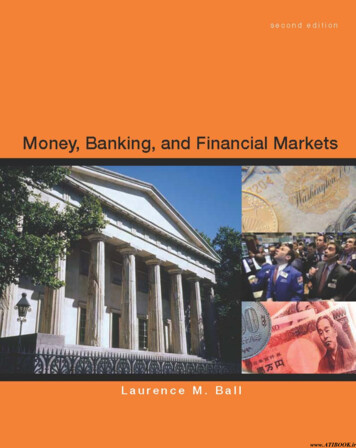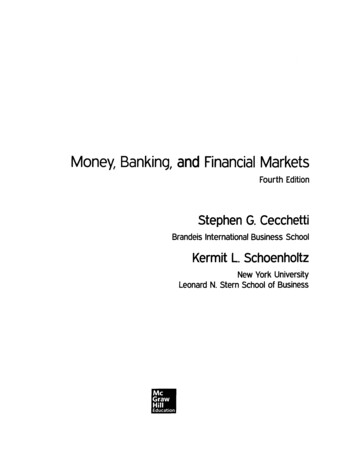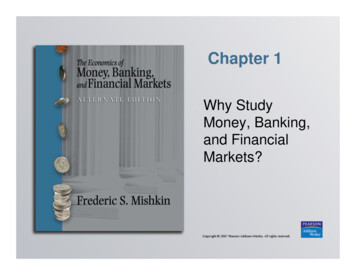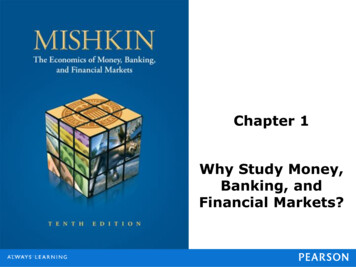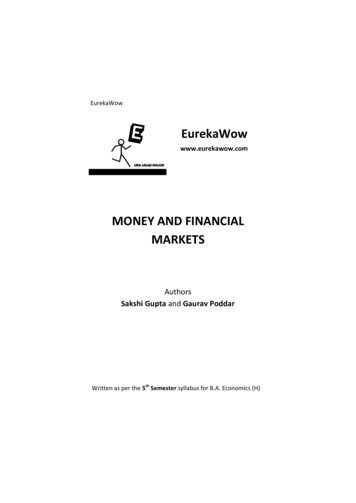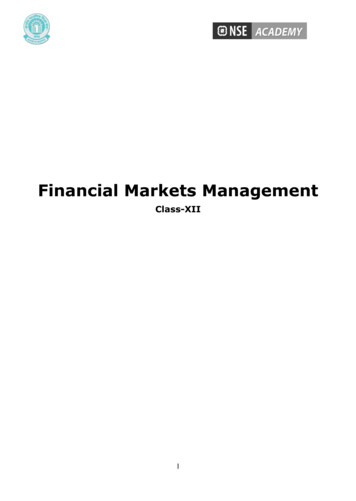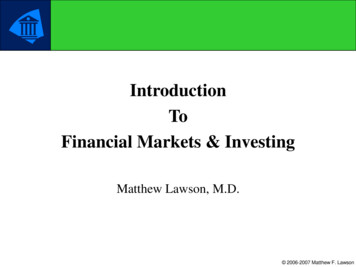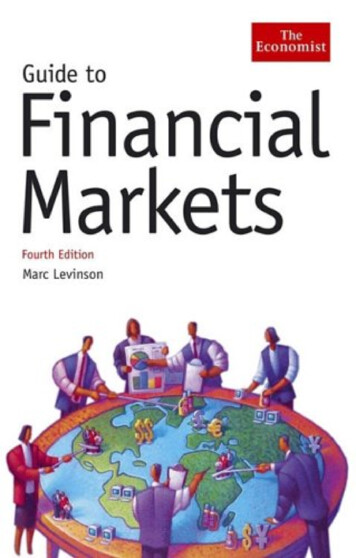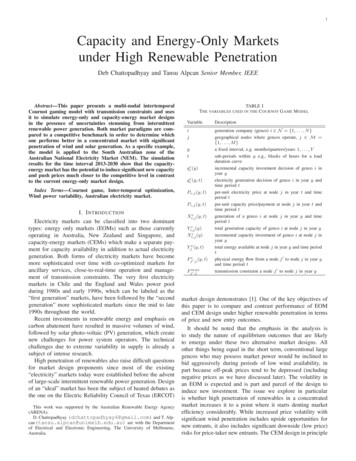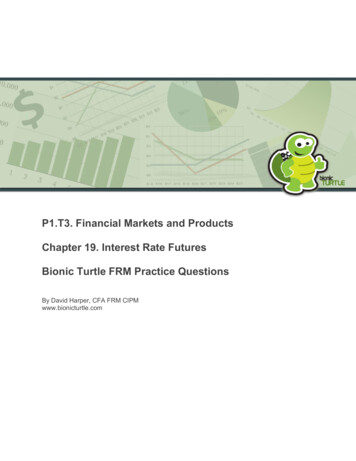
Transcription
P1.T3. Financial Markets and ProductsChapter 19. Interest Rate FuturesBionic Turtle FRM Practice QuestionsBy David Harper, CFA FRM CIPMwww.bionicturtle.com
Key Ideas According to DavidINTEREST RATES . 3FUTURES/FORWARDS (COMMODITIES) . 4INTEREST RATE FUTURES . 5SWAPS . 5OPTIONS AND OPTION TRADING STRATEGIES. 6Chapter 19. Interest Rate FuturesP1.T3.719. QUOTED VERSUS CASH BOND PRICES. 8P1.T3.720. US TREASURY BONDS: CONVERSION FACTORS, CHEAPEST-TO-DELIVER &THEORETICAL FUTURES PRICE .12P1.T3.721. EURODOLLAR FUTURES CONTRACTS AND DURATION-BASED HEDGING .15P1.T3.168. DAY COUNT CONVENTIONS .18P1.T3.169. MONEY MARKET (T-BILL) DISCOUNT RATES .20P1.T3.170. CLEAN VERSUS DIRTY BOND PRICES .22P1.T3.171. CONVERSION FACTORS (CF) & CHEAPEST-TO-DELIVER (CTD) .25P1.T3.172. EURODOLLAR FUTURES PRICING (AND CONVEXITY) .28P1.T3.173. EURODOLLAR FUTURES AND DURATION-BASED HEDGES .31Hull: Options, Futures & Other Derivatives– Ch.6 - EOC Q&AHULL 6.1 .33HULL 6.2 .34HULL 6.3 .35HULL 6.4 .35HULL 6.5 .36HULL 6.6 .36HULL 6.7 .37HULL 6.8 .37HULL 6.9 .38HULL 6.10 .39HULL 6.11 .40HULL 6.12 .41HULL 6.13 .42HULL 6.14 .44HULL 6.15 .44HULL 6.16 .45HULL 6.17 & 6.18 .45HULL 6.19 .46HULL 6.20 .46HULL 6.21 .46HULL.06.22: .47HULL 6.23 .47HULL 6.24 .48HULL 6.25 .48HULL 6.26 .49HULL 6.27 .49HULL 6.28 .50HULL 6.29 .522
Key Ideas According to DavidBefore 2020, these questions were covered by Hull, Options, Futures & Other Derivatives.Although GARP has separated the chapters into different readings, we are retainingthese key ideas in each of the corresponding documents. Interest rates Futures/Forwards (Commodities) Interest rate futures Corporate Bonds Swaps Options and option trading strategiesInterest RatesThree skills will put you in a good position: compound frequencies; present value (bond) pricingbased on discounted cash flow; and implied forward rates given spot rates:1. You do need to be fluent with compound frequencies. Probably, like the last exam,the default compound frequency will be annual. However, you still need to be ready toconvert. If a rate is 8.0% per annum with annual compounding, you should easily be ableto convert to its semi-annual and continuous equivalents.2. Probably the most basic pricing skill is “vanilla” bond pricing; by vanilla, I refer to a basiccoupon-bearing or zero-coupon bond. For example, given a zero rate curve (5% @ 0.5years, 5.8% at 1.0 year, 6.4% at 1.5 years, and 6.8% at 2.0 years, each continuouslycompounding), what is the price of a two-year 100 face bond that pays a semi-annualcoupon at a coupon rate of 6.0%. You should be able to do this.3. GARP likes to test the implied forward rate given the spot rate curve. You canalmost expect to be asked. For example, if the 2-year spot rate is 1.2% and the 3-yearspot rate is 1.4%, you should be able to infer the one-year forward rate, f(2,3), undercontinuous, annual and/or semi-annual compound frequencies. Please note that GARP like a price-based variation on the implied forward rate,which I reviewed here at -toforward-rates-if-you-have-bond-prices.4927/3
Futures/Forwards (Commodities)This is a potentially deep topic. But I think your focus should be on the following: Cost of carry; i.e., be facile with computing the implied model forward price. Butplease do not only practice solving for F(0). You must be sufficiently comfortablesuch that you can, for example, extract the convenience yield if given F(0).The minimum variance hedge ratio is extremely likely to be tested; I included twoexamples in the FR, given it appears every yearPlease practice the optimal hedge (minimum variance) with both commodities andequity portfolios (hedged with index futures)I think margin accounts are testable (initial and maintenance margins for the futurespositions that are used to hedge)With respect to futures contract sizes, I think you should know that T-bond futuresare standardized at 100,000; Eurodollars at 1,000,000; and S&P 500 at a 250multiple (*250). They are likely to be provided, but are common enough that it helpsto just know them. More detail here s-contract-sizes.4959/Be comfortable with contango/backwardation (observed) and normalcontango/backwardation (unobserved)Do you need to memorize the size of commodity contracts?Probably an exam question will provide you with contract size, rather than assume you know.Although, I do think it is good practice to know the following due to their exam popularity: Treasury bonds: 100,000 (GARP may assume you know)S&P 500: 250 * index futures price (popularly used for questions)Eurodollar: 1,000,000And the following are not uncommon: Gold: 100 troy ounces (I agree with you)NASDAQ 100: 100 * index futures priceS&P & NASDAQ MINI contracts: one-fifth (1/5th); i.e., 50* and 20*Crude oil: 1,000 barrelsSilver: 5,000 ounces (maybe, do most people know this? I don't think so.)Corn ( wheat): 5,000 bushels (popular in quizzes)Copper: 25,000 poundsWhere can you find these? http://www.cmegroup.com/ opper contract specifications.html4
Interest rate futuresI think you should focus on:Day count conventionsUnderstanding the mechanics of the Eurodollar futures contract and Treasury bondfutures contractsGARP likes to test cheapest-to-deliver (CTD); i.e., given three or four eligible bonds,identify the CTDDefinitely be ready to compute the number of interest rate futures contracts used toduration hedge a fixed-income position. If you are given two durations, you do NOT wantto hedge with the current durations, but RATHER the expected forward durations atmaturity. SwapsI think the assignment (Hull) divides into three: comparative advantage; swap mechanics; andswap valuation. We have several practice questions on comparative advantage (it reduces tothe observation that the total net gain equals the difference between fixed and floating ratedifferentials), but historically this tricky idea has barely been tested to my knowledge. Youclearly need to be comfortable with swap mechanics so you can answer a very basic, nonquantitative question like one I included in the Focus Review (FR):GARP 2010.P1.12. The yield curve is upward sloping, and a portfolio manager has a longposition in 10-year Treasury Notes funded through overnight repurchase agreements. The riskmanager is concerned with the risk that market rates may increase further and reduce themarket value of the position. What hedge could be put on to reduce the position’s exposure torising rates?a)b)c)d)Enter into a 10-year pay fixed and receive floating interest rate swap.Enter into a 10-year receive fixed and pay floating interest rate swap.Establish a long position in 10-year Treasury Note futures.Buy a call option on 10-year Treasury Note futures.5
Some key (exam) points to keep in mind with respect to swap mechanics: The vanilla interest rate swap (IRS) references notional; i.e., the notional is notexchanged (But the principal is exchanged in a currency swap, hence the maximumpotential future [credit] exposure of a currency swap occurs at maturity)By default, the floating rate is determined at the beginning of each period and paid at theend; e.g., the first fixed-rate settlement is known at swap inceptionThe duration of a swap position can be inferred from its valuation treatment as consistingof two bond legs: just as value[swap, POV of fixed-rate receiver, floating-rate payer] value[fixed-rate bond] - value[floating-rate bond], the duration of the IRS from theperspective of the fixed-rate receiver (who is effectively long the fixed-rate bondequivalent and short the floater) is approximately equal to the duration of the fixed-ratebond-equivalent. For example, the (modified) duration of a swap with a 3-year tenor,from the perspective of a 4.0% fixed rate payer is about 2.8 years at settlement becausethe duration equals 2.8 years (i.e., fixed rate bond) minus about zero (duration offloating-rate bond is time-to-next-coupon).In regard to swap valuation, you must practice a few. You'll quickly see that it's just like pricing abond but with a tiny additional step, where the key insight is that the floating-rate bondequivalent, for valuation purposes, only requires a single cash flow due to the elegant fact that itprices exactly at par at the next settlement. In the FR, I included the classic sort of swapvaluation that you could see on the exam:GARP 2011.P1.E1.10. A bank had entered into a 3-year interest rate swap for a notionalamount of USD 300 million, paying a fixed rate of 7.5% per year and receiving LIBOR annually.Just after the payment was made at the end of the first year, the continuously compounded 1year and 2-year annualized LIBOR rates were 7% per year and 8% per year, respectively. Thevalue of the swap at that time was closest to which of the following choices?Options and option trading strategiesIn collecting the three-year sample of exam-type questions, I was surprised at the highprevalence of put-call parity in the FRM. Historically, put-call parity questions are very common.(Please note this is a T3 summary and does not include discussion of option pricing models,OPM, which are T4 topics). It is essential that you memorize, and are utterly comfortable with,the put-call parity formula; for example, can you, without any reference, quickly produce theformula's equivalent of
In collecting the three-year sample of exam-type questions, I was surprised at the high prevalence of put-call parity in the FRM. Historically, put-call parity questions are very common. (Please note this is a T3 summary and does not include discussion of option pricing models, OPM, which are T4 topics). It is essential that you memorize, and .

